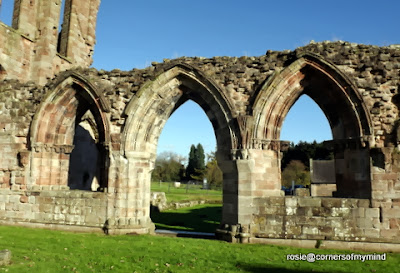On the way back from our visit to Sudbury last Saturday we diverted from the road home to visit Croxden Abbey. It is a few years since we last visited, and I wrote a post at the time, but it was nice to visit again and to take advantage of the afternoon sunshine, although it did make for some difficulties in taking photos as the sun, low in the sky, cast long shadows across the ruins.
The abbey was founded
around 1179 by Bertam de Verdun, Lord of Alton for the Cistercian
order of 'white monks' who came from Normandy in France. Quite a lot of
it still stands including the imposing remains of the 13th century
church, infirmary and abbot's lodgings.
The
Monks who lived here observed the strict rule of St Benedict. They also bred sheep and made a good income from wool
production. They tried also to be self-sufficient and there would have been a mill and fish ponds in the grounds of the abbey.
The monks lived in peace with their surroundings for 350 years
until the dissolution of the monasteries during the reign of Henry VIII.
When the Abbey was
in it's infancy the community of monks were French but the first Abbot,
Thomas of Woodstock, was an English man
The Abbey flourished in the 13th century and supported as many as seventy monks but during the 14th century this community suffered and was depleted by successive crop failures, cattle disease and the plague.
When the Abbey was finally
closed in September 1538 there were still 12 monks and an Abbot living
there, probably the same number of residents as in it's first years.
Bertam de Verdun
founded the Abbey for the purpose of the salvation of the souls of
himself, his wife, his mother and other family members. The plan for
the Abbey was based on that of the 'mother-house' at Aunay-sur-Odon.
Many of the 13th Century additions were instigated by Abbot Walter of
London.
The stone coffins that can be seen near the remains of the high altar are the tombs of the founding family and other benefactors.
The road through the small hamlet of Croxden passes through the middle of the ruins which are on private farm land but administered by English Heritage.










I've never heard of Croxden Abbey.... it looks like a good place to visit. Thanks for taking us along with you x
ReplyDeleteIt is quite a small abbey in comparison to some but very interesting in its landscape - glad you enjoyed the visit:)
DeleteSuch an historic place. If only the Abbey could talk. x
ReplyDeleteI wonder what stories it would tell, Simone - a panorama of social and political history no doubt:)
DeleteWhat a beautiful place Rosie. I can almost hear the Gregorian chant echoing around the cloisters. I didn't know about Croxden, but have visited Fountains Abbey, which was also founded by the Cistercians. I see a great similarity and now I know why, if they were built in the style of the mother-house.
ReplyDeleteEnjoy your weekend.
Marie x
I remember Fountains Abbey we went with some friends to a Victorian evening and wandered around the ruins in costume - a lot bigger and more impressive than Croxden but still the feeling of history and mystery:)
DeleteOne of my favourite places to visit in Suffolk is Clare Priory - it has such a wonderful brooding atmosphere and is the burial ground of some of the relatives of Richard III. I go as often as I can to the ruins and then wander through the neglected orchard. The dissolution of the monasteries was an appalling act of vandalism, but we still have some amazing ruins to cherish
ReplyDeleteClare Priory sounds wonderful Marianne and I'd be interested in the Richard III connection too. I always think ruins are so evocative as Simone said above - if only those walls could speak:)
DeleteThis is a lovely Abbey Rosie and so full of history. Your photos give us such an insight into what it once would have looked like.
ReplyDeletePatricia x
Thanks, Patricia - it is amazing that so much of it is left as it has been on farmland since the Dissolution - anything could have happened to it I suppose - in some areas such places have completely disappeared and the stone used in other buildings:)
DeleteA fascinating visit to Croxden. It must have looked so impressive in the landscape before it became a ruin (although it makes a magnificant ruin, now) I love the photograph of the autumn sunlight through the windows.
ReplyDeleteIt's interesting that even before the dissolution the number of monks had dwindled.
It was quite a small abbey and it does make for wonderful ruins. When we drove away from the village and back up the hill to the road home we could see the ruins down in the valley and they looked wonderful:)
DeleteI enjoyed reading this as I've been to Croxden a couple of times but either didn't take in the information or have since forgotten it! Interesting and some lovely pictures too.
ReplyDeleteIt is a super place to go - usually so quiet too. There were two others visiting whilst we were there and a couple in a car having a picnic. Glad you enjoyed going back for a while:)
DeleteCroxden Abbey looks very mystical. I wonder how long the stone coffins have been there and why they weren't buried.
ReplyDeleteThere were a couple of excavations in the 1950s and 1970s so perhaps they were unearthed and left exposed then. I expect the contents were re-interred somewhere else at the Dissolution:)
Delete